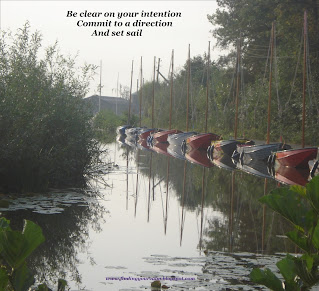Do you want to feel
more committed to the things you want to do?
Do you feel your
attention is split and you end up wasting time?
Another topic that is
spoken about a great deal in the personal development world is ‘setting an
intention’. It is often spoken about in relation to ‘The Law of Attraction’ and
how to attract the things you want to bring into your life. But, as is often
the case, it is a very simple and easy concept that has been dressed up to be
more than it is.
At its root it is
about setting goals. Whether it is a day to day task, or a much larger project,
an ambition or dream, it is about getting the idea in your head and defining it
for yourself.
You can write it down,
you can say it out loud, whatever works for you, but the very basis is stating
it in some form so you are clear on exactly what you want, or intend to do, whether it is that day,
that week, that month or even that year.
The focus here is in
the act of actually stating your intention – that is ‘setting’ it.
By doing this you have
a direction to move in, you have a purpose, an action to take, one that will
bring you closer to what you want to achieve. Your mind can focus on the steps
you need to take to complete it.
“Where focus goes, energy flows.”–
Tony Robbins
For me, writing it
down works. It enables me to refer to it as many times as I need and break down
the steps into manageable chunks. If I get distracted or become unclear about
what I need to do, I can look at it again. This repetition helps solidify the
intention and set it as a foundation to build on – hence, the term ‘setting an
intention’.
As a writer, I approach
it like a story: I have a direction, a few scenes, and an ending in mind, which
I move towards. Occasionally I get caught up in a character or go off into a
side story, so I remind myself of my original plan, what my intention for the story was, the original
core idea and return my focus to it.
But whether you are a
writer or not, breaking it down into small steps – some of them small enough to
do on a daily basis – makes it easier to see your progress and feel like you
are getting somewhere and believe it is possible. Decide on a physical action or on an amount
of time each day you want to devote to it.
“Action is the foundational key
to all success.” – Pablo Picasso
And if you feel
overwhelmed by the enormity of what you are aiming for, or struggle to believe
you can achieve it, return to the reason behind it – your ‘Why’. This helps
refresh your motivation and the initial intention behind what you are trying to
achieve. It will keep you moving forward, and keep up the momentum needed to hold
on to the commitment you made to yourself.
Part of feeling you
have achieved anything is trusting yourself and not letting yourself down; being
proud of yourself for holding on and following through no matter how many times
you feel you have failed.
You need to invest in
yourself and connect with your truth – what you really want in your heart of
hearts – to be able to succeed.
“Investing and Connecting is one
of the key factors in turning any intention into reality”. - Rhonda Britten
The cross over with
the ‘Law of Attraction’ is the idea that if you focus on the things you want
you can ‘attract’ them to you. If you remain committed, you can make it happen.
If you believe you can and remind yourself why you want to, and keep moving
forward towards it with consistent, persistent action, anything is possible.
So, by ‘setting an
intention’ of what you want to do, you are already turning your mind to it, you
are already opening doors to it, and how to go about achieving it, actively
looking for opportunities. This in turn will uncover them and you will learn
new things, meet new people and keep progressing towards that intention.
“Our intentions create our
reality.” – Wayne Dyer
So each time you have
a bad day, or think you have failed in something you want to do, remind
yourself of what you are trying to achieve; remind yourself of the reason
behind it and commit to it again.
You can set an intention
every single day.
You can write a new
‘to do’ list every day.
You can do one small
thing towards your goal every day.
It’s all down to believing that you can and
then taking action.
That is what is behind
‘setting an intention’.
“The successful warrior is the
average man with laser-like focus.” – Bruce Lee


